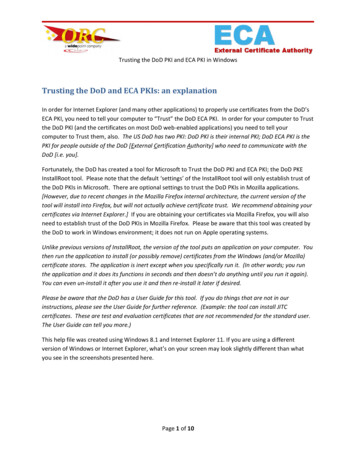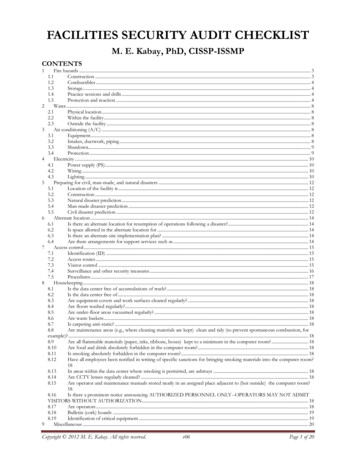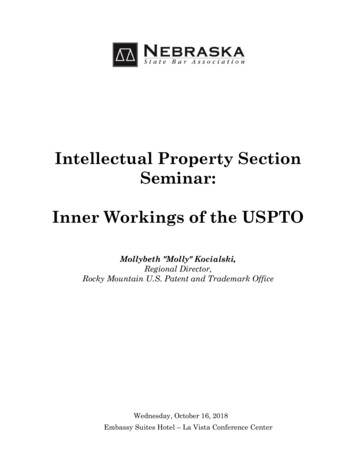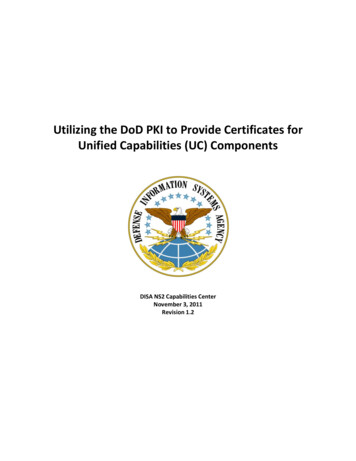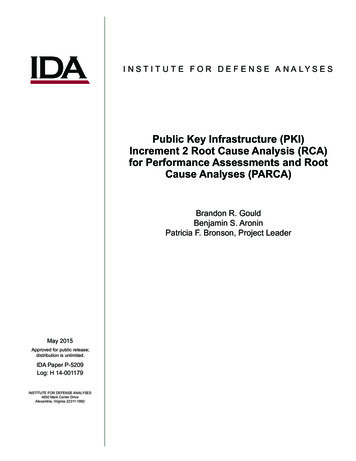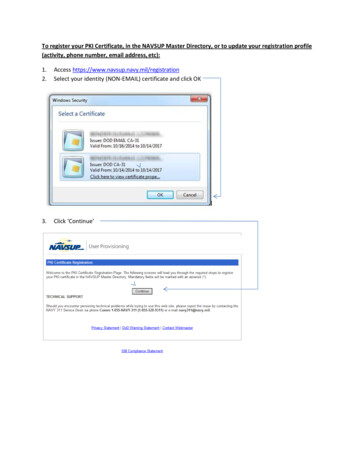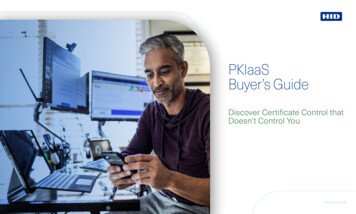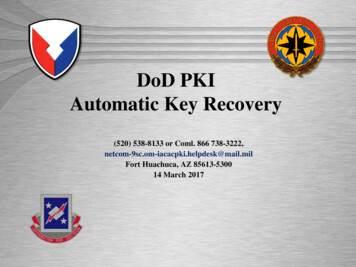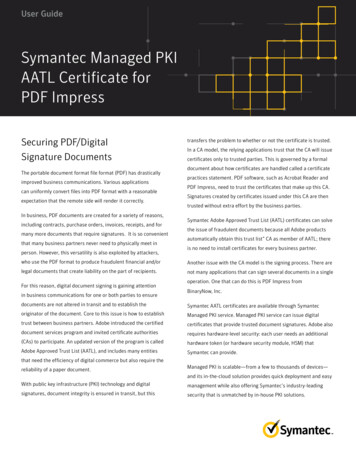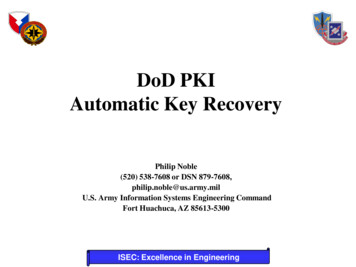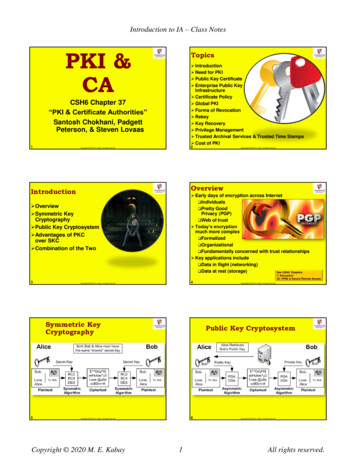
Transcription
Introduction to IA – Class NotesPKI &CATopics Introduction Need for PKI Public Key Certificate Enterprise Public KeyInfrastructure Certificate Policy Global PKI Forms of Revocation Rekey Key Recovery Privilege Management Trusted Archival Services & Trusted Time Stamps Cost of PKICSH6 Chapter 37“PKI & Certificate Authorities”Santosh Chokhani, PadgettPeterson, & Steven Lovaas12Copyright 2020 M. E. Kabay. All rights reserved.Copyright 2020 M. E. Kabay. All rights reserved.OverviewIntroduction Early days of encryption across Internet Individuals Pretty GoodPrivacy (PGP) Web of trust Today’s encryptionmuch more complex Formalized Organizational Fundamentally concerned with trust relationships Key applications include Data in flight (networking) Data at rest (storage)See CSH6 Chapters Overview Symmetric KeyCryptography Public Key Cryptosystem Advantages of PKCover SKC Combination of the Two7: Encryption32: VPNs & Secure Remote Access34Copyright 2020 M. E. Kabay. All rights reserved.Symmetric KeyCryptography5Public Key Cryptosystem6Copyright 2020 M. E. Kabay. All rights reserved.Copyright 2020 M. E. KabayCopyright 2020 M. E. Kabay. All rights reserved.1Copyright 2020 M. E. Kabay. All rights reserved.All rights reserved.
Introduction to IA – Class NotesAdvantages of PKC over SKCCombination of the Two PKC requires fewer keys to manage Total keys 2n (Cf SKC with ½n(n-1) ½n2) Can focus on authenticating onlypublic keys No secret keys transmitted overnetworks Not susceptible tocompromise even if publickeys must be changed Public keys can be used toencrypt temporary session keysfor one-time use Session keys allow PKC toencrypt message for multiplerecipients easily Usual implementation of PKC uses symmetricalgorithm for session key Computationally less onerous Encrypt session key with asymmetric key Digital signing uses similarmethod Encrypt secure hash ofdocument Decrypt encrypted hash toverify data integrity andauthenticity of text78Copyright 2020 M. E. Kabay. All rights reserved.Copyright 2020 M. E. Kabay. All rights reserved.Need for PKIPublic Key Certificate (1) Everything in PKC depends on trustworthiness(authenticity) of the public key (certificate) If someone posts a public key invictim’s name, can Intercept encryptedcontent intended forspoofed victim Issue fraudulentcontent in victim’sname Similar problems withSecure Sockets Layer (SSL)v2 Develop chain of trust forcertificates (value signed bypublic keys)9 Certification authority (CA) issues signatures for publickeys Standard is ANSI X.509 (IETFRFC 5280) Described in Abstract SyntaxNotation (ANS.1) Often encoded in MIME(Multipurpose Internet MailExtensions) to use onlyASCII characters Trust the root & you can trust theissued keys10Copyright 2020 M. E. Kabay. All rights reserved.Certificate Revocation ListPublic Key Certificate (2) CRL is list of revoked certificates Must check CRL before trusting public key X.509v2 CRL contains Version # of CRL standards Algorithm & parameters for CA signature CA name CRL issuance time Next CRL issuance time (optional) List of revoked certificates witheach Certificate serial # Time CA notified of revocation Extensions (optional) Extensions related to CRL (optional) CA’s digital signatureEvery CA’s certificate has list of key info: Version # Certificate serial # Algorithm CA name Validity period for certificate Subscriber name Subscriber public key, PKalgorithm, parameters CA unique ID (optional) Extensions (optional) CA’s digital signature1112Copyright 2020 M. E. Kabay. All rights reserved.Copyright 2020 M. E. KabayCopyright 2020 M. E. Kabay. All rights reserved.2Copyright 2020 M. E. Kabay. All rights reserved.All rights reserved.
Introduction to IA – Class NotesEnterprise Public KeyInfrastructure13Certificate Policy (1) Private keys must be Kept confidential Used only by owners of keys Trust anchors’ public key integritymust be assured Initial authentication of subscriber Must be strong Must prevent identity theft at time ofcertificate creation CA & RA (Registration Authority) computer systemsmust be protected against tampering Requirements for level of trust must be defined14Copyright 2020 M. E. Kabay. All rights reserved.Certificate Policy (2)Copyright 2020 M. E. Kabay. All rights reserved.Global PKI Levels of Trust Proofing Trusted Paths Choosing a PKIArchitecture Cross-Certification PKI Interoperability1516Copyright 2020 M. E. Kabay. All rights reserved.Levels of TrustProofing OMB M04-04 §2.1 basic levels of trust: Level 1: Little or no confidence in assertedidentity’s validity Level 2: Some confidence Level 3: High confidence Level 4: Very high confidence17 Vetting (proofing) requires increasinglythorough background checking of identity18Copyright 2020 M. E. Kabay. All rights reserved.Copyright 2020 M. E. KabayCopyright 2020 M. E. Kabay. All rights reserved.3Copyright 2020 M. E. Kabay. All rights reserved.All rights reserved.
Introduction to IA – Class NotesChoosing a PKI ArchitectureTrusted Paths Strict Hierarchy Hierarchy Bridge Multiple Trust Anchors Mesh (Anarchy, Web) Making a Choice1920Copyright 2020 M. E. Kabay. All rights reserved.Strict HierarchyCopyright 2020 M. E. Kabay. All rights reserved.Hierarchy Strict hierarchy requires public key ofcommon ancestor as trust anchor Thus single root is trust anchor Nonstrict hierarchy allows any CA to be trustanchor Usually local CA becomes trust anchor Local CA is CA that issued certificate to arelying party2122Copyright 2020 M. E. Kabay. All rights reserved.BridgeCopyright 2020 M. E. Kabay. All rights reserved.Multiple Trust Anchors Relying party obtains public keys of manyCAs Must use secure method Each key becomes a trust anchor Helpful for situations where CAs cannotcross-certify each other2324Copyright 2020 M. E. Kabay. All rights reserved.Copyright 2020 M. E. Kabay4Copyright 2020 M. E. Kabay. All rights reserved.All rights reserved.
Introduction to IA – Class NotesMaking a ChoiceMesh (Anarchy, Web) Factors Management culture Organizational politics Certification path size Subscriber populationsize Subscriber populationdistribution Revocation information Often end up with multipleCAs Web of trust Any CA can trust any other Original concept underlyingPGP Not scalable (WHY NOT?)2526Copyright 2020 M. E. Kabay. All rights reserved.Cross-Certification (1)Copyright 2020 M. E. Kabay. All rights reserved.Cross-Certification (2) Simplest case: Two CAs grant the other acertificate Problems Incompatible PKI products Incompatible certificationpolicies Must review policies Need equivalent, not identicalpolicies Use name constraints extension in X.509v3certificates Trust each others’ domain names2728Copyright 2020 M. E. Kabay. All rights reserved.Copyright 2020 M. E. Kabay. All rights reserved.PKI InteroperabilityCross-Certification (3)Factors Trust Path CryptographicAlgorithms Certificate & CRLFormats Certificate & CRLDissemination Certificate Policies Names2930Copyright 2020 M. E. Kabay. All rights reserved.Copyright 2020 M. E. Kabay5Copyright 2020 M. E. Kabay. All rights reserved.All rights reserved.
Introduction to IA – Class NotesTypes of Revocation-NotificationMechanismsForms of Revocation Types of Revocation-Notification Mechanisms Certificate Revocation Lists & Variants Server-Based Revocation Protocols Summary of Recommendations31 Concerns about CRLs have ledto variations for checkingvalidity of certificates Online Certificate StatusProtocol (OCSP) RFC 2560 Directory-based verification &revocation B-tree revocation lists32Copyright 2020 M. E. Kabay. All rights reserved.Certificate Revocation Lists &Variants Most versatile, effective & recommended Variations Full & complete CRL (rare) All certificates, revoked and valid Most CRLs have only recent revocations Authority revocation list (ARL) – usually short Revocations only for CAs Don’t use X.509v1 ARL – only X.509v2,which distinguishes between CRL & ARL Distribution-point CRL: allows partitionsfor shorter lists Delta CRL: changes only since last CRL33Copyright 2020 M. E. Kabay. All rights reserved.Server-Based Revocation Protocols Servers provide revocation info; e.g., On-Line Certificate Status Protocol (OCSP) Simple Certificate Validation Protocol(SCVP) Flaws Need to secure channel to server Computationally intensive digitalsignature generation makes systemdifficult to scale Need trusted servers Useful when need to Have thinnest possible PKI clients Generate revenue for CA services Check changing credentials Update changing credentials 34Copyright 2020 M. E. Kabay. All rights reserved.Summary ofRecommendations for CRLsCopyright 2020 M. E. Kabay. All rights reserved.Recommendations Use combination of CRLs Replication of CA directory entry for fast access ARLs & their consolidation Consolidation of reason-codes of keycompromise in a domain Use Distribution Point extension Issue CRL frequently Partition routine revocation info usingDistribution Point CRLs if CRLs become too large Store plaintext CRLs for fast searching Eliminate private information to eliminate need forauthentication when searching CRLs3536Copyright 2020 M. E. Kabay. All rights reserved.Copyright 2020 M. E. Kabay6Copyright 2020 M. E. Kabay. All rights reserved.All rights reserved.
Introduction to IA – Class NotesRekeyEstimating Brute-ForceCracking time Public key certificates eventuallyexpire Thus need new PKcertificates Don’t use PKs longer thanestimated time for brute-forcecryptanalysis Cryptanalysis threat period Shortens all the time ascomputational power increases Current estimates 1024 bit RSA key 25 years in 2009 & 1.5 now Why? Therefore worthwhile recertifying keys Reduce number of keys necessary to accessor validate older files/messages3738Copyright 2020 M. E. Kabay. All rights reserved.Copyright 2020 M. E. Kabay. All rights reserved.Key Recovery (2)Key Recovery (1) Distinguish between signing keys & data encryption keys Signing keys must never be subject to key recovery! Data encryption keys may be protected by keyrecovery Key escrow Provide privatedecryption key to keyrecovery agent (KRA) Key encapsulation Encrypt privatedecryption key usingKRA’s public key Avoiding giving KRA control May not want KRA to have unfetteredaccess to decryption key So can Superencrypt Encrypt using 2 keys Requires collaboration toget key Split the key: Shamir’s n outof m rule Send parts of key to m recipients Require at least n recipients tocollaborate in restoring key3940Copyright 2020 M. E. Kabay. All rights reserved.Copyright 2020 M. E. Kabay. All rights reserved.Trusted Archival Services &Trusted Time StampsPrivilege Management PKI does not prevent alteration or spoofing Merely detects them Could also challenge digital signature after expiry ofcryptanalysis threat period But can use trusted archivalservices Need to provide storage ofsigned materials Trustworthy assurance oferror-free transcription frommedium to medium over timeas media degrade &technologies change Can add functions of trusted time stamps4142Copyright 2020 M. E. Kabay. All rights reserved.Copyright 2020 M. E. Kabay7Copyright 2020 M. E. Kabay. All rights reserved.All rights reserved.
Introduction to IA – Class NotesProf Kabay’s Notes onHR v IT for CACost of PKI Compare costs of PKI with costs of nothaving PKI! Scalability is key factor:n vs n2 keys Consider consequences of untrusteddigital communications Continued dependence on trust IT Can support software for issuing andrevoking certificates But have no information about new hires,changes of position, authorization as CAs,deauthorization or firing HR Equipped to handle all employee-relatedissues Issuing/revoking certificates run bysoftware Therefore appropriate CAsM. E. Kabay’s question sent in 2001 to Norwich University authoritieswho resisted digital signatures on documents sent by e-mail:How is depending on pigment smeared through a holein the end of a stick onto compressed fibers from dead plantssupposed to engender more trust in the authenticity and integrityof a document than cryptographically sound digital signatures?4344Copyright 2020 M. E. Kabay. All rights reserved.Copyright 2020 M. E. Kabay. All rights reserved.Now go andstudy45Copyright 2020 M. E. Kabay. All rights reserved.Copyright 2020 M. E. Kabay8All rights reserved.
Key Recovery (1) Distinguish between signing keys & data encryption keys Signing keys must never be subject to key recovery! Data encryption keys may be protected by key recovery Key escrow Provide private decryption key to key recovery agent (KRA) Key encapsulation Encrypt private decryption
